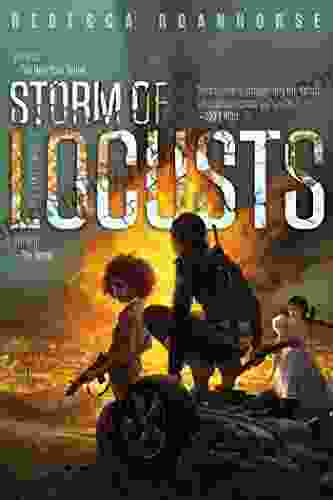The Devastating Storm of Locusts: A Harbinger of the Sixth World?

In recent months, a devastating swarm of locusts has swept across East Africa, the Middle East, and South Asia, threatening food security and livelihoods for millions of people. The swarms are the largest in decades, and experts warn that they could have a catastrophic impact on the region.
4.6 out of 5
| Language | : | English |
| File size | : | 2360 KB |
| Text-to-Speech | : | Enabled |
| Screen Reader | : | Supported |
| Enhanced typesetting | : | Enabled |
| X-Ray | : | Enabled |
| Word Wise | : | Enabled |
| Print length | : | 321 pages |
Locusts are a type of grasshopper that can form massive swarms that can travel hundreds of miles in a single day. They eat crops, trees, and other vegetation, leaving behind a trail of destruction. The current swarm is estimated to be over 350 miles long and 60 miles wide, and it is rapidly spreading.
The locusts are causing widespread damage to crops, particularly in Kenya, Ethiopia, Somalia, and Yemen. In some areas, they have wiped out entire fields, leaving farmers with nothing to harvest. The swarms are also a threat to livestock, as they can consume the vegetation that animals rely on for food.
The locust outbreak is a major challenge for governments and humanitarian organizations. They are struggling to control the swarms and provide assistance to the affected communities. The swarms are difficult to track and kill, and they can quickly spread to new areas.
The locust outbreak is a reminder of the fragility of our food systems. The world is already facing a hunger crisis, and the locusts could make the situation even worse. The outbreak is also a warning about the potential impacts of climate change. Warmer temperatures and changes in rainfall patterns are creating conditions that are more favorable for locust outbreaks.
The locust outbreak is a major challenge, but it is also an opportunity to learn from our mistakes and to build more resilient food systems. We need to invest in research to develop new ways to control locusts and to help farmers cope with the impacts of climate change. We also need to work together to provide assistance to the communities that are most affected by the locusts.
Causes of the Locust Outbreak
There are a number of factors that have contributed to the current locust outbreak. These include:
- Climate change: Warmer temperatures and changes in rainfall patterns are creating conditions that are more favorable for locust outbreaks.
- Conflict: Conflict in the region has disrupted agricultural activities and made it difficult to control locusts.
- Lack of resources: Governments and humanitarian organizations do not have the resources to effectively control locust outbreaks.
Impacts of the Locust Outbreak
The locust outbreak is having a devastating impact on the region. The swarms are causing widespread damage to crops, livestock, and livelihoods. The outbreak is also a threat to food security and nutrition in the region.
The economic impacts of the locust outbreak are also significant. The swarms are causing billions of dollars in losses to farmers and businesses. The outbreak is also disrupting trade and tourism.
Controlling the Locust Outbreak
There are a number of ways to control locust outbreaks. These include:
- Chemical control: Pesticides can be used to kill locusts. However, this method can be harmful to the environment and to human health.
- Biological control: Natural enemies of locusts, such as birds and wasps, can be used to control outbreaks.
- Physical control: Barriers can be used to prevent locusts from entering crops. Traps can also be used to catch locusts.
Building Resilience to Locust Outbreaks
In addition to controlling locust outbreaks, it is also important to build resilience to the impacts of locusts. This can be done by:
- Investing in research: Research is needed to develop new ways to control locusts and to help farmers cope with the impacts of locust outbreaks.
- Providing assistance to affected communities: Governments and humanitarian organizations need to provide assistance to the communities that are most affected by locust outbreaks.
- Promoting sustainable agriculture: Sustainable agriculture practices can help to reduce the risk of locust outbreaks.
The locust outbreak is a major challenge, but it is also an opportunity to learn from our mistakes and to build more resilient food systems. We need to invest in research, provide assistance to affected communities, and promote sustainable agriculture. By working together, we can overcome the challenges posed by locust outbreaks and build a more food-secure future.

Source: FAO
4.6 out of 5
| Language | : | English |
| File size | : | 2360 KB |
| Text-to-Speech | : | Enabled |
| Screen Reader | : | Supported |
| Enhanced typesetting | : | Enabled |
| X-Ray | : | Enabled |
| Word Wise | : | Enabled |
| Print length | : | 321 pages |
Do you want to contribute by writing guest posts on this blog?
Please contact us and send us a resume of previous articles that you have written.
 Top Book
Top Book Novel
Novel Fiction
Fiction Nonfiction
Nonfiction Literature
Literature Paperback
Paperback Hardcover
Hardcover E-book
E-book Audiobook
Audiobook Bestseller
Bestseller Classic
Classic Mystery
Mystery Thriller
Thriller Romance
Romance Fantasy
Fantasy Science Fiction
Science Fiction Biography
Biography Memoir
Memoir Autobiography
Autobiography Poetry
Poetry Drama
Drama Historical Fiction
Historical Fiction Self-help
Self-help Young Adult
Young Adult Childrens Books
Childrens Books Graphic Novel
Graphic Novel Anthology
Anthology Series
Series Encyclopedia
Encyclopedia Reference
Reference Guidebook
Guidebook Textbook
Textbook Workbook
Workbook Journal
Journal Diary
Diary Manuscript
Manuscript Folio
Folio Pulp Fiction
Pulp Fiction Short Stories
Short Stories Fairy Tales
Fairy Tales Fables
Fables Mythology
Mythology Philosophy
Philosophy Religion
Religion Spirituality
Spirituality Essays
Essays Critique
Critique Commentary
Commentary Glossary
Glossary Bibliography
Bibliography Index
Index Table of Contents
Table of Contents Preface
Preface Introduction
Introduction Foreword
Foreword Afterword
Afterword Appendices
Appendices Annotations
Annotations Footnotes
Footnotes Epilogue
Epilogue Prologue
Prologue L E Fitzpatrick
L E Fitzpatrick Sharon Walpole
Sharon Walpole Frank Scozzari
Frank Scozzari Rhonda Byrne
Rhonda Byrne Marjolein Visser
Marjolein Visser Enoch Brater
Enoch Brater Marcella Dipaolo
Marcella Dipaolo Jeremy Martin
Jeremy Martin Casey Morris
Casey Morris Thomas L Good
Thomas L Good Helena Hunting
Helena Hunting Todd R Tresidder
Todd R Tresidder Naoshi Komi
Naoshi Komi Peter Nealen
Peter Nealen David Ramsay
David Ramsay Laura Scott
Laura Scott Alice Hiller
Alice Hiller Adrian Onyando
Adrian Onyando Adrian Ernesto Cepeda
Adrian Ernesto Cepeda Rose Macaulay
Rose Macaulay
Light bulbAdvertise smarter! Our strategic ad space ensures maximum exposure. Reserve your spot today!

 Owen SimmonsPushcart Peyton Chaska: A Journey of Creativity, Resilience, and Unwavering...
Owen SimmonsPushcart Peyton Chaska: A Journey of Creativity, Resilience, and Unwavering...
 José MartíAn In-Depth Exploration of Jesuit Off Broadway: Unlocking the Artistic Legacy...
José MartíAn In-Depth Exploration of Jesuit Off Broadway: Unlocking the Artistic Legacy... Edward ReedFollow ·3k
Edward ReedFollow ·3k Dennis HayesFollow ·15.1k
Dennis HayesFollow ·15.1k Jamie BlairFollow ·19.2k
Jamie BlairFollow ·19.2k Mario Vargas LlosaFollow ·10.4k
Mario Vargas LlosaFollow ·10.4k Braden WardFollow ·13.5k
Braden WardFollow ·13.5k Dion ReedFollow ·16.9k
Dion ReedFollow ·16.9k Gabriel BlairFollow ·13.4k
Gabriel BlairFollow ·13.4k Federico García LorcaFollow ·13k
Federico García LorcaFollow ·13k

 Thomas Powell
Thomas PowellHair Care Essentials for Crochet Braids: A Protective...
Crochet braids are a versatile and...

 Philip Bell
Philip BellNative Nations of North America: A Comprehensive Guide
North America is home to a...

 Jackson Hayes
Jackson HayesCall Me Crazy: My Unique Journey with Green
In the kaleidoscopic tapestry of life, where...

 Graham Blair
Graham BlairUnveiling the Literary Treasures of Michigan: A Journey...
The literary landscape of...
4.6 out of 5
| Language | : | English |
| File size | : | 2360 KB |
| Text-to-Speech | : | Enabled |
| Screen Reader | : | Supported |
| Enhanced typesetting | : | Enabled |
| X-Ray | : | Enabled |
| Word Wise | : | Enabled |
| Print length | : | 321 pages |












